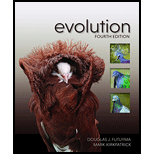
Concept explainers
To distinguish: Between the rate of
Introduction: Diversity is defined as the number of species or genera in many evolutionary studies. Analysis of changes in diversity can be done by studying paleontology and by the phylogenetic relationship among the species. Changes in speciation and diversification can be studied using a number of taxa (N). Speciation rate is represented as S while diversification rate is represented as D.
Explanation of Solution
The differences between the rate of speciation and diversification rate are mentioned as follows:
| No. | Character | Rate of Speciation | Rate of Diversification |
| 1. | Definition | Speciation rate refers to the probability of one species “giving birth” to another species over a short period of time represented as dt. | Diversification rate is defined as the average increase or decrease in diversity per taxon. |
| 2. | Representation | Speciation rate is represented by S. | D is used to represent the rate of diversification. |
| 3. | Calculation | Rate of speciation can be calculated by dividing the change in the number of species per unit time. | Subtracting speciation rate from extinction rate gives the rate of diversification. |
To explain: The relationship between the rate of speciation, a number of species and the rate of diversification.
Introduction: Diversity is defined as the number of species or genera in many evolutionary studies. Speciation rate refers to the probability of one species “giving birth” to another species over a short period of time which is represented as dt. Diversification rate is defined as the average increase or decrease in diversity per taxon.
Explanation of Solution
Subtracting speciation rate from extinction rate gives a rate of diversification represented as D. Speciation rate would be greater than the extinction rate if the value of D is greater than 1. A decline in the number of species would be observed if the value of D is negative. There will be an exponential increase or decrease in the number of species if the value of D remains constant over a period of time.
Want to see more full solutions like this?
- Differentiate between allopatric and sympatric speciation. What mechanisms of evolution are most likely in each case to cause divergence?arrow_forwardIf the phylogenetic species concept (PSC) were used to define species, rather than the biological species concept (BSC), how might that change the estimates of species diversity (numbers of species) on a worldwide basis? True or False: Estimates of species diversity are likely to change if the PSC is used. In particular, one would expect the number of species to increase. This is because individuals from divergent allopatric populations that can potentially interbreed would belong to the same species under the BSC. These same organisms would be classified as members of different species under the PSC.arrow_forwardHow does diversifying could result in sympatric speciation?arrow_forward
- What is the basic difference between the allopatric and sympatric modes of speciation?arrow_forwardWhat are the most common mechanism of sympathric speciation and in which major group of organisms does this happen most often? Distinguish between sympathric and allopathric and parapathric speciation. Which is considered the (far) more common mechanism of species formation? What does "gene flow"between populations do?arrow_forwardWhat are five geographic barriers that might lead to allopatric speciation?arrow_forward
- What are the most common mechanisms of sympatric speciation and in which major group of organisms does this happen most often? Distinguish between sympatric, allopatric and parapatric speciation. What is considered the (far) more common mechanism of species formation? What does "gene flow" between populations mean?arrow_forwardWhat are the most common mechanisms of sympatric speciation and in which major group of organisms does this happen often? Distinguish between sympatric, allopatric and parapatric speciatio. Which is considered the (far) more common mechanism of species formation? What does "gene flow" between populations do?arrow_forwardWhich of the following statements about sympatric speciation is correct? It is a process through which two populations can diverge and develop reproductive isolation while in two different geographic area. It is the most common mechanism for populations to form independent species. Postzygotic isolation is the main form of reproductive isolation for the sympatric speciation process. Genetic isolation through large scale chromosomal mutations, such as chromosome inversion or polyploidy, are more likely contributing to sympatric speciation. None of the abovearrow_forward
- What are the 3 mechanisms of microevolution? And tell if speciation is an example of macroevolution?arrow_forwardWhat is Allopatric speciation? A) When a population is separated from the main group by a barrier and becomes a new species B) When a population mutates into a new species C) When a population develops into a new species without any physical barriers to isolate themarrow_forwardWhat conditions make it likely that a small group of closely related species will increase to a large number of species by means of rapid speciation?arrow_forward
 Human Anatomy & Physiology (11th Edition)BiologyISBN:9780134580999Author:Elaine N. Marieb, Katja N. HoehnPublisher:PEARSON
Human Anatomy & Physiology (11th Edition)BiologyISBN:9780134580999Author:Elaine N. Marieb, Katja N. HoehnPublisher:PEARSON Biology 2eBiologyISBN:9781947172517Author:Matthew Douglas, Jung Choi, Mary Ann ClarkPublisher:OpenStax
Biology 2eBiologyISBN:9781947172517Author:Matthew Douglas, Jung Choi, Mary Ann ClarkPublisher:OpenStax Anatomy & PhysiologyBiologyISBN:9781259398629Author:McKinley, Michael P., O'loughlin, Valerie Dean, Bidle, Theresa StouterPublisher:Mcgraw Hill Education,
Anatomy & PhysiologyBiologyISBN:9781259398629Author:McKinley, Michael P., O'loughlin, Valerie Dean, Bidle, Theresa StouterPublisher:Mcgraw Hill Education, Molecular Biology of the Cell (Sixth Edition)BiologyISBN:9780815344322Author:Bruce Alberts, Alexander D. Johnson, Julian Lewis, David Morgan, Martin Raff, Keith Roberts, Peter WalterPublisher:W. W. Norton & Company
Molecular Biology of the Cell (Sixth Edition)BiologyISBN:9780815344322Author:Bruce Alberts, Alexander D. Johnson, Julian Lewis, David Morgan, Martin Raff, Keith Roberts, Peter WalterPublisher:W. W. Norton & Company Laboratory Manual For Human Anatomy & PhysiologyBiologyISBN:9781260159363Author:Martin, Terry R., Prentice-craver, CynthiaPublisher:McGraw-Hill Publishing Co.
Laboratory Manual For Human Anatomy & PhysiologyBiologyISBN:9781260159363Author:Martin, Terry R., Prentice-craver, CynthiaPublisher:McGraw-Hill Publishing Co. Inquiry Into Life (16th Edition)BiologyISBN:9781260231700Author:Sylvia S. Mader, Michael WindelspechtPublisher:McGraw Hill Education
Inquiry Into Life (16th Edition)BiologyISBN:9781260231700Author:Sylvia S. Mader, Michael WindelspechtPublisher:McGraw Hill Education





